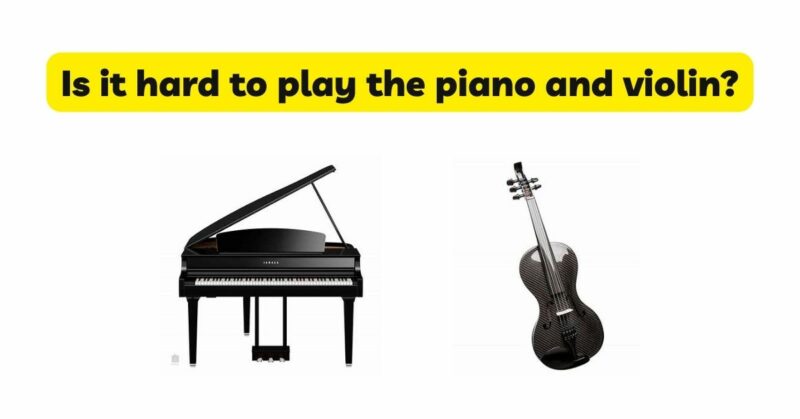Learning to play a musical instrument requires dedication, perseverance, and a willingness to face challenges. The piano and the violin, two iconic instruments with rich musical traditions, are no exceptions. In this article, we will delve into the difficulties encountered when learning to play the piano and the violin, exploring technical challenges, theoretical complexities, physical demands, and the rewards that come with overcoming these hurdles. By understanding the challenges and rewards associated with piano and violin playing, aspiring musicians can better prepare themselves for the journey ahead and embrace the fulfillment that comes with mastering these instruments.
Technical Challenges: Piano vs. Violin
The piano and the violin present distinct technical challenges. Learning to play the piano requires the development of finger independence, coordination between both hands, and the ability to play different melodies, harmonies, and rhythms simultaneously. Pianists must master the art of controlling dynamics, balance, and touch, utilizing the full range of the keyboard. The complexity of playing multiple voices and managing intricate passages poses a significant technical challenge.
On the other hand, the violin demands precise finger placement, intonation control, and mastery of bowing technique. Violinists must develop a keen ear for pitch, as the instrument has no frets to guide finger placement. The coordination required between the left hand, responsible for finger positions, and the right hand, which controls the bow, is a unique challenge that violinists must overcome. The complex and intricate nature of violin technique, including bow control, vibrato, and shifting, adds further layers of difficulty.
Theoretical Complexities: Piano vs. Violin
Both the piano and the violin involve a level of theoretical understanding. Piano players must grasp music theory concepts such as scales, chords, harmonies, and complex rhythms. They need to read two staves of music simultaneously, interpret different dynamic markings, and understand musical phrasing. The ability to interpret and convey the intended musical expression through nuances is crucial for pianists.
Violinists also encounter theoretical complexities, such as understanding scales, keys, and musical structures. However, their focus is more centered around melodic lines, tonalities, and expressive techniques. Violinists must learn to interpret music and convey emotions through their playing, capturing the subtleties of phrasing and dynamics.
Physical Demands: Piano vs. Violin
The physical demands of playing the piano and the violin should not be overlooked. Pianists must develop strength and dexterity in their fingers, as well as arm and wrist flexibility. The sustained playing and repetitive motions involved in piano playing require proper posture and a relaxed yet controlled approach. Building finger strength and agility takes time and consistent practice.
Violinists face physical demands that are unique to their instrument. Holding the violin correctly requires a specific posture, including the positioning of the left hand, the balance of the instrument on the shoulder, and the correct placement of the chin on the chinrest. Developing the necessary strength and stability to hold the instrument comfortably can take time and practice. Additionally, bowing technique requires precise control of the bow with the right arm, wrist, and fingers, which can be physically demanding and requires continuous refinement.
Overcoming Challenges: Persistence and Practice
While piano and violin playing present challenges, they are not insurmountable. With persistence, dedication, and consistent practice, aspiring musicians can overcome the difficulties associated with these instruments. Patience and a willingness to break down complex passages into smaller, manageable parts are essential. Building a strong technical foundation, practicing with intention, and seeking guidance from qualified teachers can accelerate progress and help navigate the learning process.
The Rewards of Mastery: Musical Expression and Personal Fulfillment
The challenges of piano and violin playing are met with immense rewards. As musicians develop proficiency on these instruments, they unlock a world of musical expression and personal fulfillment. The piano’s vast range and polyphonic capabilities allow pianists to create rich harmonies, explore dynamic contrasts, and express themselves through a wide spectrum of emotions. The violin’s melodic and expressive qualities, akin to the human voice, enable violinists to communicate deeply and evoke powerful emotions through their playing.
Mastering the piano and the violin allows musicians to connect with the music at a profound level, expressing their unique interpretations and creativity. The ability to bring life to the written notes, shape phrases, and communicate emotions through sound is a deeply rewarding experience. The personal growth, self-discipline, and perseverance cultivated through the journey of learning these instruments are invaluable and extend beyond the realm of music.
Conclusion
Playing the piano and the violin is not without its challenges, but the rewards make the journey worthwhile. Overcoming technical difficulties, understanding theoretical complexities, and meeting the physical demands of these instruments require perseverance, practice, and guidance. However, the sense of accomplishment, the fulfillment of expressing oneself through music, and the joy of mastering these versatile and expressive instruments far outweigh the initial challenges.
Ultimately, the difficulty of piano and violin playing should be viewed as a natural part of the learning process, rather than a deterrent. With patience, dedication, and a love for music, aspiring pianists and violinists can embark on a rewarding journey that offers personal growth, artistic expression, and a lifelong appreciation for the beauty of these instruments. The challenges faced along the way become stepping stones towards achieving musical excellence and realizing the profound fulfillment that comes with playing the piano and the violin.


